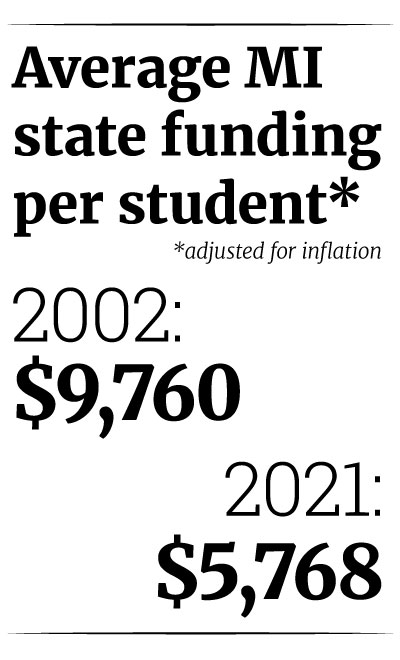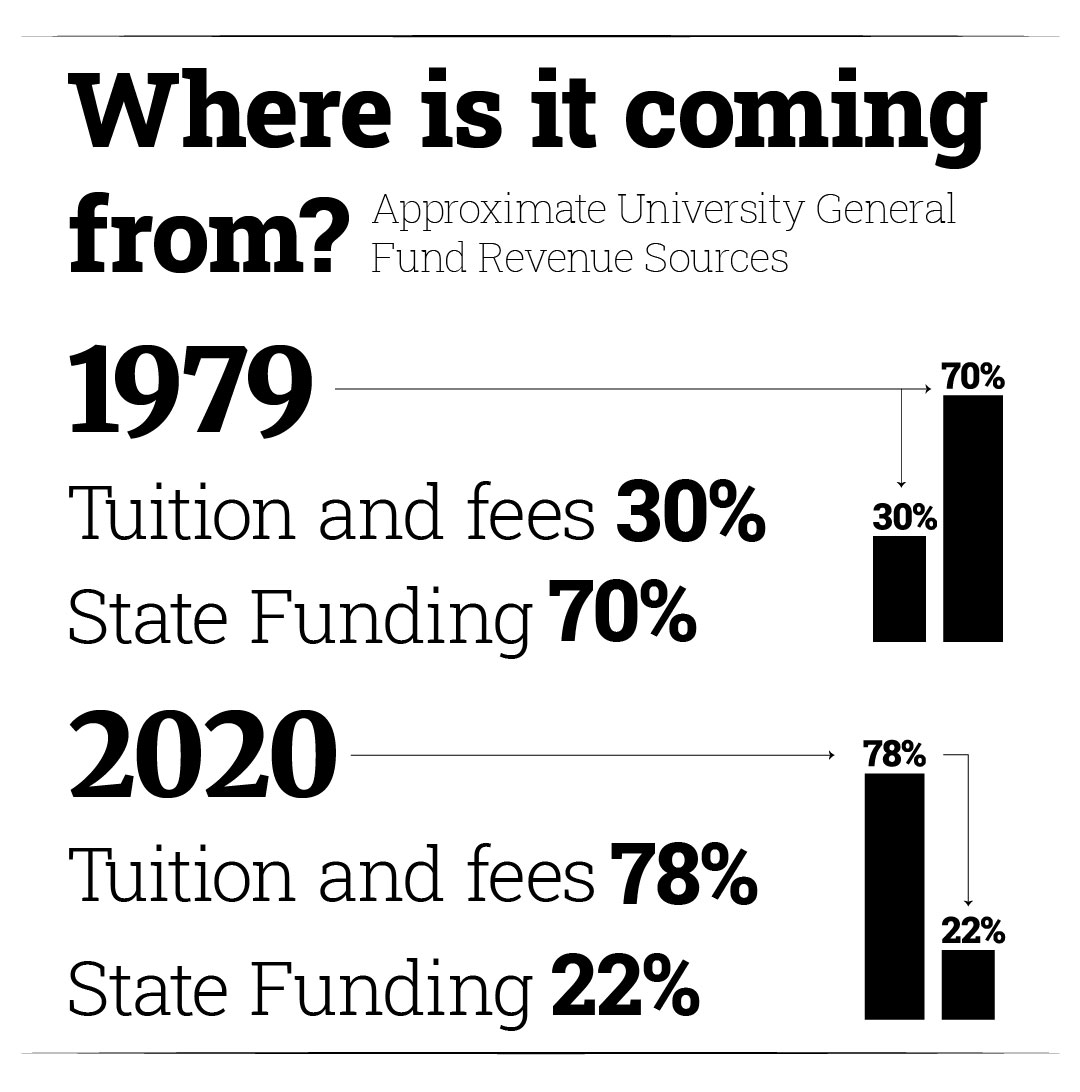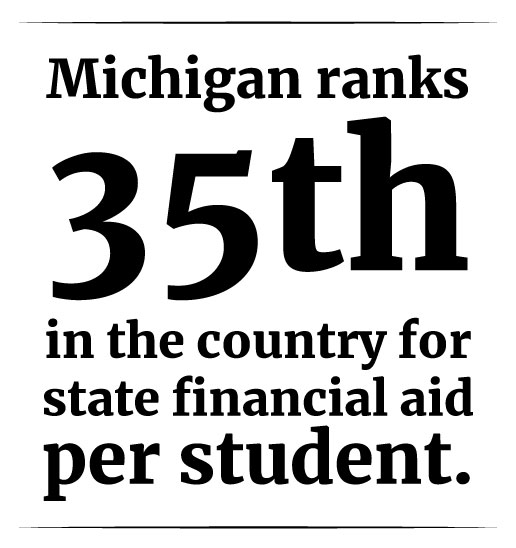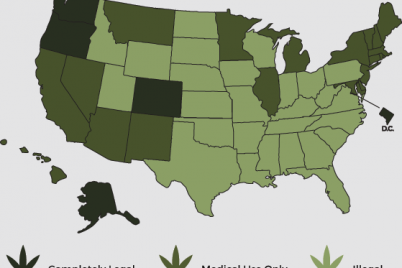Between rising tuition and stagnant wages, many of today’s college students are forced to weigh the true value of a degree.
While there are many factors that can influence a school’s decision to raise tuition, college officials point to one key culprit: a consistent decline in state funding over the last few decades.
Many factors, ranging from economic downturns to politics, can inspire state lawmakers to slash higher education funding.
A few months ago, Daniel Hurley, CEO of the Michigan Association of State Universities, gave a presentation to the state House of Representatives that attempted to draw attention to this issue.
According to Hurley’s presentation, the average funding per student has decreased from $9,760 in 2002 to $5,768 in 2021 when adjusted for inflation. The presentation also noted state appropriations accounted for about 70 percent of university general fund revenues in 1979. Tuition and fees accounted for about 30 percent. In 2020, appropriations accounted for about 22 percent of general fund revenues and tuition and fees accounted for about 78 percent.
The presentation also noted state appropriations accounted for about 70 percent of university general fund revenues in 1979. Tuition and fees accounted for about 30 percent. In 2020, appropriations accounted for about 22 percent of general fund revenues and tuition and fees accounted for about 78 percent.
(See Part 1 of this story: Why is four-year college tuition so high?)
Rick Fitzgerald, the assistant vice president for public affairs at U of M, echoed this sentiment, saying, “State funding and tuition have traded places as the main source of revenue for the university’s academic mission.”
According to Hurley, the biggest reason that appropriations for higher education have decreased so much is that state lawmakers are “not making higher education a priority.”
According to a document titled “Higher Education Funding History” published by the Senate Fiscal Agency, state general fund appropriations for the 2020-21 academic year were about $1.2 billion, down from about $1.8 billion in 2001-02.
Funding has increased since the 2018-19 academic year, when it was less than $1.1 billion.
According to Senator Jeff Irwin, a Democrat who represents Michigan’s 18th district, “Funding for higher education has been on a downward swing really since the early ‘80s.”
“The biggest blow was probably in 2011 when Gov. (Rick) Snyder cut 15 percent across the board for higher ed,” said Irwin.
State appropriations for the 2010-11 academic year were about $1.07 billion, down from about $1.49 billion the previous year.
What is causing the decline?
While politics have played a significant role in these cuts, the economy has also played a role.
“It’s not just politics, it’s also that when times get tough and you’re looking to cut budgets, at the state level there’s only a few big areas that you can cut,” said Irwin. “And so what happens is when times do get tough, higher education winds up taking a hit, and then when times get better, they don’t get that turnabout.” According to Hurley, “Typically, when the economy improves, the states will re-invest significantly in higher ed. In Michigan, that hasn’t happened.”
According to Hurley, “Typically, when the economy improves, the states will re-invest significantly in higher ed. In Michigan, that hasn’t happened.”
Hurley said that one reason higher education, in particular, is so vulnerable to cuts is that other areas, such as K-12 education, are harder to cut because there is no alternative source of funding.
“Lawmakers don’t like to see tuition go up, but the fact is, they know that if they cut state funding, institutions have another revenue valve that they can turn on, and that’s tuition,” said Hurley.
According to Irwin, “What we’ve done year after year after year is give increases to these institutions that are significantly lower than inflation.”
In other words, even though state funding for colleges may increase slightly year over year, those increases are so small that they aren’t keeping up with the costs of running those schools.
Benefits of higher education
 According to Hurley, increasing funding for higher education is a worthwhile investment from an economic perspective.
According to Hurley, increasing funding for higher education is a worthwhile investment from an economic perspective.
“The level of talent in the state is the most important economic development factor. And so I think that the state disinvestment in higher education over the years has had a very substantial impact on our economy,” said Hurley.
According to Hurley, degree attainment is associated with higher incomes, which ultimately results in more tax revenue coming back to the state.
According to Irwin, “The higher level of education attainment among a state’s population also translates to a decreased need for social welfare and social insurance programs.”
COVID
Over the past year, the economic impact of the COVID-19 Pandemic has raised questions about whether lawmakers will try to cut budgets in the future to try and make up for reduced tax revenue and increased use of “safety nets” like unemployment.
Since economic downturns have led to decreases in higher education funding in the past, it begs the question of whether the pandemic will lead to less funding for colleges in the years to come. Hurley believes that the states should have enough money to fund colleges, at least in the short run.
Hurley believes that the states should have enough money to fund colleges, at least in the short run.
“Now that we’ve had three very significant federal fiscal relief packages, there is plenty of money for state lawmakers to invest, including in higher education, if they choose to do so,” Hurley said.
Irwin is also hopeful that cuts can be avoided.
He said, “One of the big differences between this crisis and the 2008 crisis is that the 2008 crisis didn’t start in 2008. Michigan went into a one-state recession pretty much at the beginning of the George W. Bush presidency.
“So the 2008 crisis really came on the heels of this long recession where the state had already been…trying to trim so many budgets.”
Since the economy was doing well pre-pandemic, Irwin is hopeful that state budgets won’t take too much of a hit.
“I am hopeful that this particular crisis is going to be less damaging to higher ed and community colleges because of the federal support that we’ve gotten,” Irwin said.
What’s the solution?
The numbers are indisputable: state funding has gone down, and tuition has gone up.
Hurley and Irwin can see several solutions to this problem.
“At a minimum, we need to provide an inflationary level of increase for these institutions,” Irwin said.
According to Irwin, Governor Whitmer has proposed a 2% increase for next year. The state legislature will decide whether or not to accept her recommendation, and there has been some pushback on the Republican side of the aisle.
Irwin also said, “We need to be increasing need-based financial aid in Michigan.”
According to Irwin, other states will allocate more money to need-based financial aid to help offset lower appropriations to the universities themselves.
Michigan ranks 35th in the country for state financial aid per student.
Many schools rely on need-based aid to help offset rising costs and make education more affordable for students.
Convincing state lawmakers that higher education is a worthwhile investment has been an uphill battle for advocates, with some calling on the federal government to step in.
Hurley has proposed an idea where “the federal government would incentivize states to invest more in their public colleges and universities by providing some matching dollars.”
With the cost of a college degree rising so much faster than incomes and inflation, the debate over funding higher education won’t disappear any time soon. Lawmakers will have to decide whether degree attainment is worth the investment.
(See Part 1 of this story: Why is four-year college tuition so high?)
Links to documents used:
- https://www.senate.michigan.gov/sfa/Departments/DataCharts/DChed_AppropsFundHistory.pdf
- https://www.senate.michigan.gov/sfa/Departments/FundHistory/FHhed_web.pdf
- https://www.senate.michigan.gov/sfa/Departments/HighlightSheet/HIhed_web.pdf




